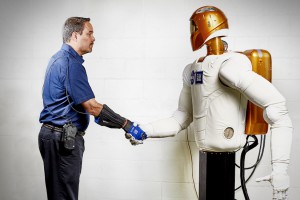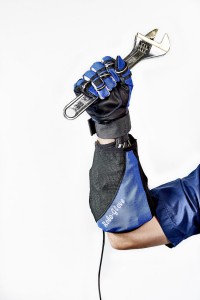
Marty Linn, General Motors manager of advanced technology and principal engineer for robotics, shakes hands with Robonaut 2 wearing the RoboGlove.
Automakers often talk about the real-world benefits of their racing programs; however, General Motors’ latest innovation requires a little more speed than the race track to get to its testing environment: outer space.
Working with a company named Bioservo Technologies AB, GM developed a robotic glove used by NASA on the International Space Station. Called the Soft Extra Muscle (SEM) Glove, it’s a glove that the user wears to help maintain a steady grip. Nicknamed “RoboGlove,” it’s a nine-year endeavor is now finding its way to Earth.
RoboGlove uses a collection of sensors, actuators and tendons that are comparable to human nerves, muscles and tendons to mimic the moves and utility of a human hand. The technology was used on NASA’s Robonaut 2 (R2) that was sent to space in 2011. As part of that mission, R2 needed to be able to operate tools designed for humans, and developers achieved unprecedented hand dexterity with the technology.
That same technology is now being applied to RoboGlove and it’s finding its way into terrestrial applications in health care and industrial applications, including manufacturing. GM intends to be the first U.S. manufacturing customer for the refined robotic glove and will test it in some of its plants.
Bioservo will initially develop a new grasp assist device for industrial use that could increase human operator efficiency while reducing fatigue in hand muscles. Research shows fatigue can occur within a few minutes of continuously gripping a tool.
(GM’s fuel-cell tech may soon power advanced Navy project. For more, Click Here.)

The RoboGlove developed by GM and NASA is a "force multipler" that adds strength and grip to the human hand to allow more consistent effort.
While it’s not a bionic hand, it can increase the strength and grip of a human hand while alleviating the stress and fatigue that often occurs during repetitive tasks that can also lead to injuries.
“The successor to RoboGlove can reduce the amount of force that a worker needs to exert when operating a tool for an extended time or with repetitive motions,” said Kurt Wiese, vice president of GM Global Manufacturing Engineering.
(Click Here to see more about NACTOY jurors getting the first run at the year’s best new vehicles.)
GM tested RoboGlove in a preproduction plant before looking for a partner, Stockholm, Sweden-based Bioservo, to help refine it to fit different size hands and address other issues. Ultimately, the glove could evolve to meet a variety of needs and find wide acceptance.
“Combining the best of three worlds – space technology from NASA, engineering from GM and medtech from Bioservo – in a new industrial glove could lead to industrial scale use of the technology,” said Tomas Ward, CEO of Bioservo Technologies.
(Auto sales outlook remains strong for second half of 2016. Click Here for the story.)
The technology combination as another step toward introducing soft exoskeleton technology globally. Bioservo will make and sell the new glove for a variety of uses including medical rehabilitation and any place additional gripping strength is needed.
